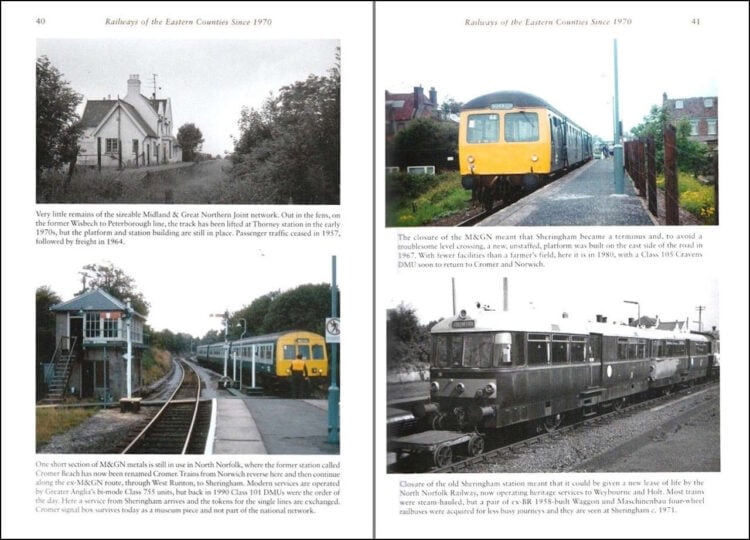This book provides an intriguing insight into how times have changed since the 1970s on the railways of the Eastern Counties, from the time when many wayside stations had a resident shunting locomotive, first generation diesel multiple units were the mainstay of most secondary lines, and locomotive haulage was the order on InterCity routes and the Harwich boat trains.
Published in November 2023 by Amberley Publishing and written by John Law, this soft cover book measures around 16.5 cm x 23.4 cm, and has 96 pages and 180 illustrations.
It has a published price of £15.99, but at the time of writing, it can be purchased for £14.39 from Amberley Publishing and for £12.29 from Amazon.
This book covers the period from before modern electric trains monopolised routes from Liverpool Street, comfortable diesel units served cross-country routes, and colour light systems replaced semaphore signalling.
Most photographs date from the late-20th century when there were still many first-generation diesel multiple units plying branch lines that had not been electrified, first-generation electric multiple units were still dominant, and typical motive power on main line duties were Class 31, 37, and 47 diesels and Class 86 electrics.
Beyond main-line operations, there are interesting images of a bus-like Waggon and Maschinenbau four-wheel railcar that was thought to be the saviour of the area's little-used branch lines, industrial locomotives, and even a photo of the Tilbury to Gravesend Ferry for which a direct railway connection no longer exists.
As well as wide geographic coverage, there are illustrations of narrow-gauge railways at Audley End, Southend Pier and Cliff railways, the Bure Valley, and the Wells and Walsingham.
Preserved standard gauge lines are not forgotten, with the East Anglian Railway Museum and the Mid Suffolk Railway.
With the book covering the period back to the 1970s, there was still plenty of pre-Beeching infrastructure in place, such as Thorney station at the top left below. At the bottom right are two of the Waggon and Maschinenbau railbuses acquired by the North Norfolk Railway for some of its services over the former Midland & Great Northern Line to Walsingham and Holt.

Although the Eastern Counties are not widely associated with industrial railways such as are to be found in the industrial heartlands of Britain, a few did exist, with an interesting locomotive being the Fireless 0-4-0 example seen at the top left below.
Although not on a mainline passenger service, the Class 47 at the top right below would have been a common sight up until the 1990s.
Many photographs in the book feature first-generation diesel multiple units, such as the ones on the left below. It is pleasing that the author has included station buildings as well as trains, as they highlight the grandeur that even some of the smallest ones displayed.
During the period covered by the book, long-distance expresses transitioned from diesel to electric haulage.
In the scenes below, there seems to be a remarkable similarity in the outline of the earlier Class 47 diesel locomotives to the Class 86 electrics, which themselves have now been superseded by electric multiple units.
With the development of Felixstowe as a container port, freight trains have become a frequent sight in the area, with Freightliner being one of the major companies as seen in the images on the left page below. The c2c line from Fenchurch Street to Southend-on-Sea and Shoeburyness is a self-contained network, with no services from other areas. Two of the line's trains are seen on the right below.
This book provides a surprisingly-varied collection of photographs illustrating the area's railways from the end of steam. A brief introduction describes the evolution of services from the time when many were locomotive hauled and all were operated by British Rail, to today's services on both main and branch lines with electric multiple units and several operating companies.
Well-written captions often add supplementary information to the photographs that is not immediately obvious.
As well as showing trains or locomotives, many of the photographs include the railway infrastructure as well as providing insights of how stations used to look before they were ravaged in the name of so-called progress, when comfortable waiting rooms were replaced by what look like bus shelters.
There is a good balance of photographs from throughout the period covered by the book, as well as some of the area's more unusual railway-related subjects such as the cliff and pier railways at Southend-on-Sea and some of the area's miniature railways.
Although the introduction states the area of coverage, there is no supporting map to show the extent of lines covered.
It would have been beneficial if the book had been divided into sections, either by years or areas, as every page simply includes the book's title instead of a more-helpful section heading; there is also no Index.
Photographs taken at the same location often appear randomly throughout the book rather than being grouped together, and the same applies to the photograph dates as they are not arranged chronologically.
The book is available to purchase from Amazon and from Amberley Publishing.
We would like to thank Amberley Publishing for providing us with a copy of the book for review.